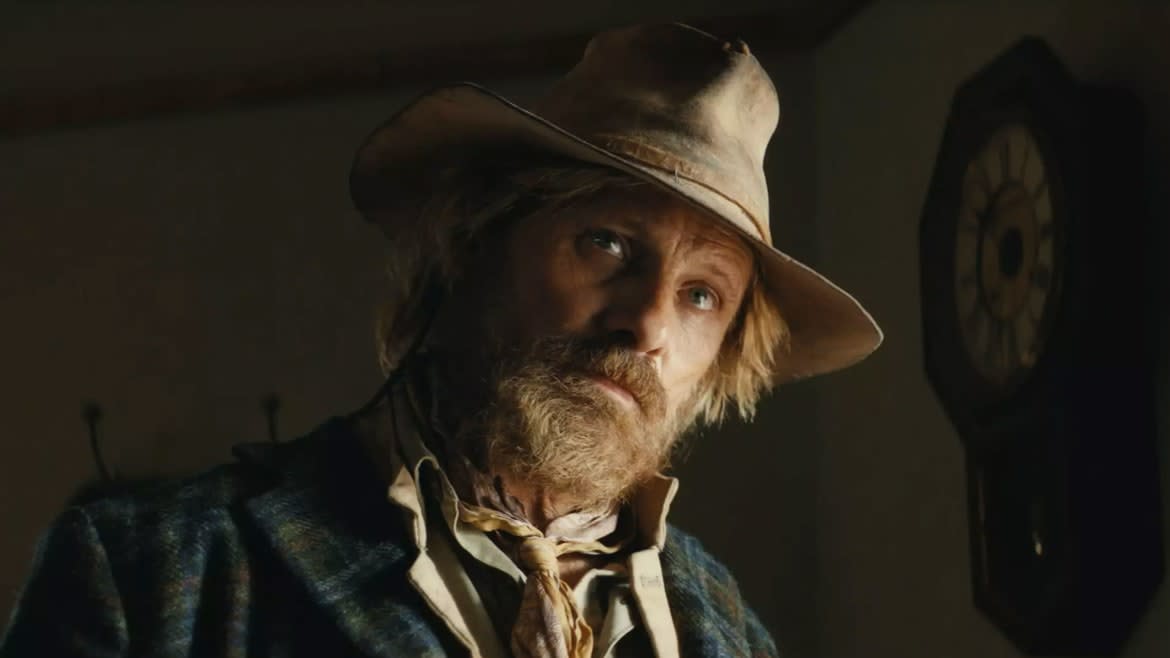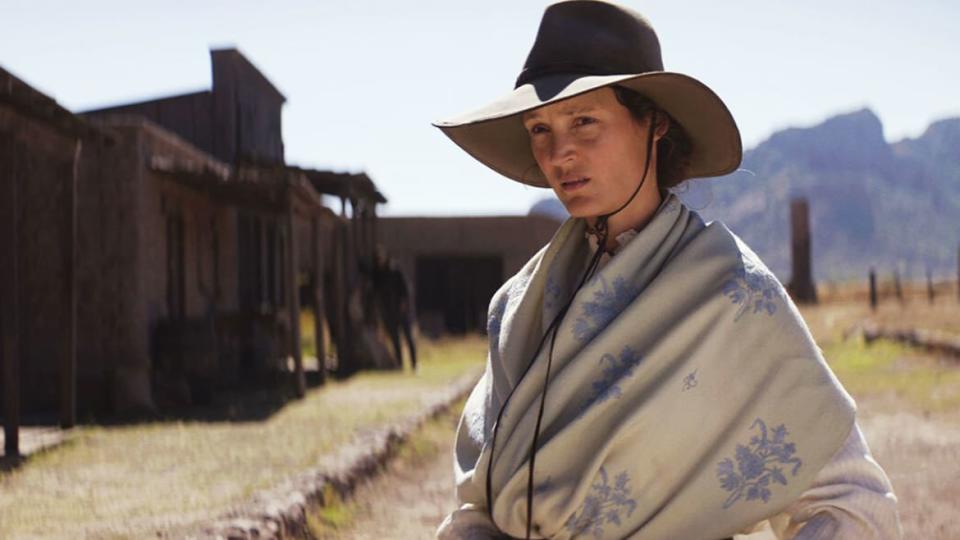‘The Dead Don’t Hurt’: Viggo Mortensen Will Make You Fall Back in Love With Westerns

While the 21st-century movie landscape has, to date, been dominated by superheroes, sequels, and animated fare, Westerns never go totally out of style. Offering battles between good and evil, right and wrong, that speak to issues of sacrifice, resilience, selfishness, regret, treachery, duty, individualism, and togetherness, they’re rugged vehicles for timeless American themes, and all of those concerns are in strong supply in The Dead Don’t Hurt. The story of an immigrant man and woman trying to make a life for themselves on the unforgiving plains, writer/director/star Viggo Mortensen’s sophomore behind-the-camera effort occasionally stumbles along its well-worn path. Still, courtesy of his and Vicky Krieps’ excellent lead performances, it delivers moving measures of the genre’s beauty, brutality, and sorrow.
The Dead Don’t Hurt, which hits theaters May 31, begins at the end, with Danish carpenter Holger Olsen (Mortensen) sitting at the deathbed of his beloved French-Canadian partner Vivienne Le Coudy (Krieps), holding her hand and closing her eyes as she dreams her last dream of a knight in shining armor riding a horse through a sunlit forest. Vivienne is buried in a grave beside their remote home, and as Holger tends to this forlorn work, he’s watched by his young son Vincent (Atlas Green). The two are soon visited by riders led by Rudolph Schiller (Danny Huston), mayor of the nearby town, who informs him that six men have recently been murdered, and that a suspect (Alex Breaux) has been arrested and is set to stand trial. During their conversation, it’s revealed that Holger is the sheriff, and the look on his face upon hearing this news implies that he knows they’ve pinned the crime on a patsy—a fact that we know as well, given the preceding depiction of the massacre.
The Dead Don’t Hurt’s real fiend is Weston Jeffries (Solly McLeod), son of local bigshot Alfred (Garret Dillahunt), although the particulars of everyone’s true nature and allegiances are revealed slowly by Mortensen, whose script flip-flops uneasily between various time periods. The film is not especially lucid at outset, and the confusion sown by its formal construction goes some way toward undercutting its initial power. Nonetheless, it gradually gains its footing as things become clearer, not only about Holger but Vivienne, who’s raised on stories about Joan of Arc and grows up wanting to fight like her father. In 1860s San Francisco as a tough and self-possessed free spirit, the adult Vivienne rebuffs the controlling advances of a wealthy aristocrat, and at a dockside market—where she formally dumps her suitor—she catches the attention of Holger, who sees in her a fetching mixture of loveliness and strength.

Vicky Krieps
Mortensen’s crosscutting between different pasts and the present is disorienting and a tad clunky, and yet his patient pacing, plaintive score, and evocative cinematography (by Marcel Zyskind) conjure an affecting mood of gentle longing, tentative happiness, and looming danger. It’s not long after their first meeting that Holger shows Vivienne the dusty and unimpressive abode and land that he calls home. Despite its general dreariness, epitomized by its lack of flowers (which she previously sold on the streets of San Francisco), Vivienne moves in and sets about transforming it into a suitable residence for them both—a mission aided by Holger, a taciturn man whose fondness for Vivienne is unmistakable and highlighted by his acquisition of materials for a garden and a barn.
Ambling along, The Dead Don’t Hurt details the burgeoning bond between Holger and Vivienne and also the dynamics of their outpost locale, where Rudolph is the mayor and the owner of the bank, and is in cahoots with Alfred to snap up the majority of the surrounding land as well as the saloon co-owned by Alan Kendall (W. Earl Brown). The wild card in their plans is Weston, whom McLeod embodies as a standard-issue man-in-black rogue with no morality to constrain his itchy trigger finger. Like everyone in the film, he’s an archetype first and a distinctive character second. Nonetheless, he exudes engaging villainous personality, which can similarly be said about the rest of these figures, many of them played by veterans of David Milch’s peerless Deadwood.
At the trial of the aforementioned accused killer, a judge (Ray McKinnon) uses the butt of a pistol as a gavel, and The Dead Don’t Hurt extends that metaphor by proving, with its latter half, that 19th-century Western justice often came via violence. Even so, there’s just as much tenderness as viciousness in Mortensen’s film. Moreover, there’s considerable sadness once Holger opts to enlist in the Union Army, thereby leaving Vivienne to fend for herself. While Krieps’ protagonist is far from a wallflower (she works at the saloon and singlehandedly builds up her ranch), this abandonment leaves her in a precarious position. Her ensuing encounters with Weston underscore that point, and come to complicate her relationship with Holger, who years later returns from the war to find that his home and wife are not quite as he remembers them. In the aftermath of his reunion with Vivienne, he must come to terms with the reality of a new and thorny situation created by his own actions.
The Violent Horror Movie That Had Made Audiences Sick to Their Stomachs
Remorse, grief, and a desire for revenge all conspire to fuel The Dead Don’t Hurt’s finale, but Mortensen refuses to cast things in wholly conventional gunslinger terms. Rather, a heavy, melancholic air hangs over the proceedings, lending it its unique tenor. Further contributing to that mood are the performances of Mortensen and Krieps; he silent and kind, and she reserved and stout, the two make for a winning pair, suggesting through heartfelt glances and gestures the bedrock warmth and understanding that unites them in this barren and inhospitable region. Though Vivienne’s death flirts with being a hackneyed plot device designed to facilitate a vengeful finale, Mortensen goes light on clichéd fireworks, and his conclusion and coda boast a wistfulness that’s more satisfying than the nasty showdown to which his story has been, since its midway point, inevitably building.
In that regard, The Dead Don’t Hurt manages to straddle a fine line between the familiar and the unexpected. Overcoming its opening temporal-fragmentation missteps, it ultimately resonates as a stirring portrait of the complex fight for survival in the Old West.
Get the Daily Beast's biggest scoops and scandals delivered right to your inbox. Sign up now.
Stay informed and gain unlimited access to the Daily Beast's unmatched reporting. Subscribe now.

 Yahoo News
Yahoo News 